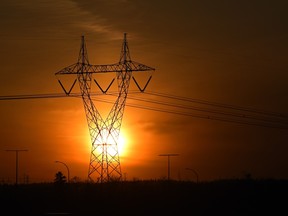
Article content
In Japan, when a bullet train arrives at its destination more than a minute late, an investigation is immediately triggered, and its swift findings made public, along with an apology and a plan to address the issue.
But when Alberta’s electrical grid was pushed to the brink across three nights in January and an emergency alert was issued to warn consumers to conserve power or face the consequences, the response that followed was high in rhetoric and low on accountability.
Advertisement 2
Article content
Article content
Although politicians were quick to use the event as evidence either for or against the case of renewables, the biggest miss in the aftermath of the brownout was a disregard for where it hurt electricity consumers the most — their wallets. While residents across Alberta did their part to keep their neighbours safe, switching off to the tune of 250 megawatts, the price of electricity hit its maximum cap of $1000/MWh, 10 times the average price.
In examining the technical documentation of the event, it appears that Alberta’s pricing mechanism and the Alberta Electricity System Operator’s (AESO) own operational procedures may have made the situation worse, in spite of their own forecasts indicating a potential shortfall two days prior to the grid alert. But have we heard an apology or a plan to fix it? No.
It’s crucial that Alberta’s electricity consumers have real authority and resources to influence decision-making around the electricity sector that directly impacts their finances and quality of life.
The sad truth is that this situation was just another example in a long line of ways that Alberta’s electricity system treats consumers: as an afterthought. Albertans already pay the highest electricity rates in Canada — twice the national average. As spring approaches, new studies and policy announcements are expected about changes to the electricity sector developed largely with an absence of consumer input.
Article content
Advertisement 3
Article content
It wasn’t always like this. Before deregulation in 2000, the government consulted with consumer associations ranging from large industrial, commercial and institutional users to special-interest agricultural groups. For groups with limited funding, the government offered financial help to allow them to participate.
Unfortunately, consumer opposition to some electrical industry initiatives led the government to eliminate this assistance and establish its own consumer advocate body. However, with a constrained mandate and ever-shrinking budget — currently less than 0.05 per cent of the $15 billion in annual expenditures for electricity supply, transmission, and distribution in Alberta — it’s hardly the champion consumers need.
For Alberta electricity consumers in 2024, there are two principal barriers to advocating for their interests. The first factor working against the average Albertan’s participation in their electricity system is its sheer complexity: From the tangled web of players working in regulated or deregulated spaces each with their own priorities and agendas, the market design, and the Alberta Utilities Commission (AUC) hearing process by which consumers are engaged.
Advertisement 4
Article content
The second is their ultimate inability to effect change. Other than attending meetings — in which they can’t participate — or reading post-facto reports — whose findings they can’t influence — there’s no meaningful way for customers to ensure their interests are represented or to exert any authority over decision-making processes.
Moreover, in 2008, the AUC was directed by government to severely limit eligible consumer engagement and has been constrained in gauging the impacts of its decisions on consumer costs. Taken together, these actions have stripped average Albertans of an effective voice at the table in making big decisions about the grid. Worse, it suggests that while frequently touting their intention of “protecting Albertans,” the government is actively undermining them.
As Jan. 13 illustrated, Albertans are willing to support the electricity system financially and through conservation efforts. It’s time they are rewarded with transparency, accountability, and a seat at the table where decisions are made.
This is what Alberta’s most diverse and representative coalition of electricity system stakeholders has put forward in Leading the Charge: A Vision for Alberta’s Electricity Future. (https://energyfutureslab.com/publications/leadingthecharge/).
Advertisement 5
Article content
It’s time for the government to recognize that without the consumer, there is no electricity market. Consumers deserve a voice and influence that reflects their investment and commitment. It’s time to give them that power.
Sheldon Fulton is an energy market consultant living in Calgary and has had an active role in the evolution of Alberta’s power market since 1996. He is also a participant in the Energy Futures Lab’s (https://energyfutureslab.com) ‘Alberta’s Electricity Future’ (https://energyfutureslab.com/innovation-challenges/albertas-electricity-future) initiative.
Article content



